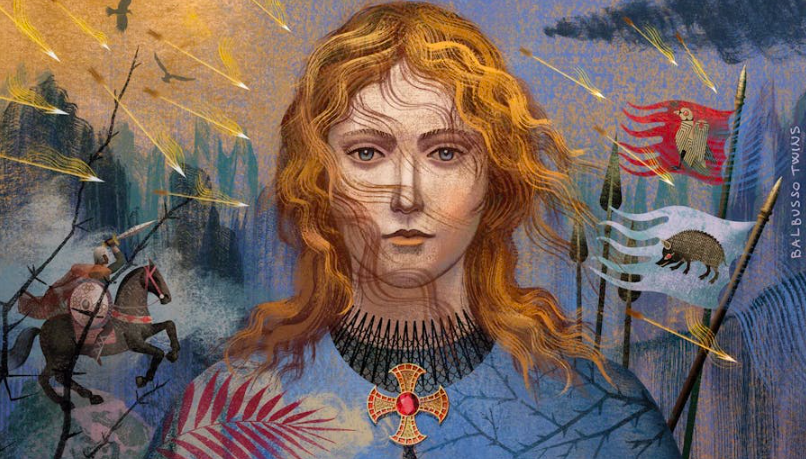Bocland: on Nicola Griffith’s Menewood and Sylvia Townsend Warner’s The Corner That Held Them

Sylvia Townsend Warner’s 1948 novel The Corner That Held Them is set in the fictional priory of Oby in the second half of the 14th century. Oby is tucked away in the marshes of Norfolk, surrounded by marginally-productive land and unreliable peasants, and perpetually on the brink of insolvency. The novel opens with adultery and murder, but quickly settles into something far less dramatic and far more interesting and original. Like a medieval monastic Seinfeld, it’s a novel about nothing. But it contains an entire world.
Warner has a genius for diffusing dramatic situations. Characters will suddenly die in the middle of a sentence that started out being about something else. In one narrative tour-de-force, she narrates a drowning death in the monastery’s fish pond from the point of view of a blind nun shut up inside her chamber, far from the actual action. Potential plots begin to take shape, then peter out. The pleasure is in the world-building. Warner has created a fictional world and filled it with flawed characters who struggle to keep it from falling apart: to collect tithes and rents, to pay off debts, to hire workers to keep the roofs thatched and the walls from falling down, to keep food on the table and the church supplied with candles, to maintain the Rule of their Order. To keep up the illusion.
On formal occasions, the nuns of Oby meet in the convent’s chapterhouse, a converted dovecote that was “allowed as a temporary expedient, and as such became permanent.” Part of the genius of Warner’s world-building is that the world she creates, though completely and convincingly worked out by the author, has the appearance of being jerry-rigged, of being constructed out of expediency and improvisation rather than through careful planning.
In one of my favorite passages in the novel, Warner describes the network of footpaths around the hamlet of Waxelby: “Along one track went the Hollys, along another the Noots, and the girl driving a lame cow past the thorn thicket must be a Scole, for that was the way the Scoles went.” The footpaths don’t lead anywhere in the narrative—they serve no purpose in the plot—but they convey the impression of a world shaped by centuries of ordinary coming and going, a world not laid out with a ruler but improvised from desire lines.
Near the beginning of the novel, a hung-over clerk named Ralph Kello appears at the gate of the convent to ask for a free breakfast, and ends up passing himself off as a priest. The convent is in need of a priest, and to the prioress Ralph seems like a gift from heaven. He becomes the nuns’ priest, knowing that the confessions he receives and the sacraments he performs will have no efficacy. He knows that he has damned himself, and contemplates extricating himself from the situation. But he never does: he fills the role of the nuns’ priest for decades. He’s perfect for the world Warner has created. He lives out his fiction as if it were real.
In her introduction to the Virago Modern Classics edition of The Corner That Held Them, Claire Harman writes: “The impression that the book consists largely of fact when it is singularly devoid of fact is another measure of how well-imagined the novel is.” I thought of Harman’s assessment of Warner’s novel as I read Nicola Griffith’s Menewood, the long-awaited sequel to Hild (2013), in which she brilliantly imagines the early life of the seventh-century woman who became St. Hild of Whitby. With few historical facts at her disposal—information about Hild’s life is largely confined to a single chapter in Bede’s 8th century Ecclesiastical History—Griffith creates a convincing fictional world that conveys the impression of being based entirely on fact.
Unlike Warner’s novel, Griffith’s has a plot that moves steadily toward a dramatic climax. The bulk of the nearly 700-page novel is framed by two historical battles, the Battle of Hatfield Chase, near Doncaster (Caer Daun), in October 633, and the Battle of Heavenfield in the following year. The battle scenes are thrilling, but as with Warner’s novel, the real pleasure in Menewood is in the world-building. Part of what makes Menewood so original and compelling is that Hild herself becomes the world-builder: in between the two great battles, Hild builds Menewood as a home for herself and her people, and rebuilds her land of Elmet after the devastation of war. In the process, she becomes the author of herself. She takes her fate into her own hands and begins to shed her image as an uncanny child, a haegtes and godmouth, and to become a powerful woman whose power comes from within herself and not from the glamorized image other people have of her.
Sylvia Townsend Warner said that she undertook the writing of her novel “on the purest Marxist terms, because I was convinced that if you were going to give an accurate picture of the monastic life, you’d have to put in all their finances; how they made their money, how they dodged about from one thing to another and how very precarious it all was.” Economics is at the heart of the novel: the rents and dowries and tithes that come in, the payments that go out, the capital expenses, the price of sheep and the wolf at the door.
Griffith has the same firm grasp of the economic details of her world: how many acres are necessary to sustain a flock, how much grain a parcel of land will produce, how goods are transported and traded, how many horses are needed in a herd, which person has the right skills for a particular job. But, like Warner, one of Griffith’s skills as a writer is her ability to avoid becoming bogged down in these details, to make them serve the double purpose of building a realistic world and of making Hild’s mastery of these details an integral part of her growth as the leader of her people.
Griffith even manages to make the potentially dry topic of land tenure interesting and important to the narrative. Early in the novel, Hild has a conversation with her husband Cian about how the priest Stephanus has been traveling the countryside “writing down who farms what land” in his boc. Griffith’s choice to use the Old English boc instead of “book” defamiliarizes the familiar object, transforming it into something new and different. Instead of taking a book for granted, we are invited to imagine it as possessing a power new to the world, something almost magical—a world-building power. Hild goes on to say: “Imagine the whole of Elmet written in that boc, written to us… No king could gainsay the boc without gainsaying the Christ on threat of their immortal soul. Imagine.” When a parcel of land is written down in the book, ownership of the land is officially recognized. It becomes bocland. There is a load of scholarship behind this brief scene, but the load is never too heavy for the plot to carry.
Menewood picks up shortly after the point where Hild left off, but ten years separate the publication of the two novels. Although Griffith provides a complete list of characters at the front of the book, my experience of the novel might have been enhanced if I had re-read Hild first to reacquaint myself with the returning characters and their backstories. In my eagerness to get started, I found myself making frequent use of the list of characters. Griffith also provides excellent maps at the front of the novel which were helpful in tracking Hild’s travels through 7th century Northumbria. For those, like me, who are interested in the research that went into creating Hild’s world, Griffith also maintains an impressive research website, which includes detailed maps that I found especially helpful in visualizing the ground covered in the book’s climactic battle.
Unlike Sylvia Townsend Warner’s haphazard nuns, always dodging about from one thing to another, Hild always has a plan. Throughout the novel she feels the burden of her responsibilities and the promptings of a wildness inside her—
A blackbird sang, liquid and unhurried. They always sounded unhurried, and they nested anywhere, seemingly without thought or planning. How would it be to not have to plan, not have to always think faster than anyone else, just to stay alive?
Because she must, Hild plans everything. And the battle at the end of the novel is a masterpiece of careful planning. But there is a point in the novel when even Hild struggles to reclaim the plot of her own life and move forward, when an accumulation of heavy losses nearly crushes her.
In her efforts to recover and rebuild, Hild is surrounded by an inner circle of battle-hardened warriors she calls her Fiercesomes. Like Hild herself, each of the Fiercesomes has been deeply scarred. One of the Fiercesomes is unable to speak and communicates in sign language, one has been castrated as the result of a wound received in battle. Their bodies have been marked and changed. Hild in particular experiences the changes, trauma, and limitations of her body throughout the novel. Nicola Griffith has been open about living with a disability for the past thirty years, and about the importance of representation and the need for more disabled characters in fiction. “It helps to see someone else coping,” she said in an interview. In a sense, Menewood is about Hild learning to cope. Not just to cope, but to reimagine what it means to be whole and to thrive.
In Menewood, Hild’s scarred body moves through a landscape that itself bears the scars of generations of warfare and occupation, going back to the redcrests (Romans) whose roads are still the main thoroughfares. At the same time, marks on parchment carry messages across the landscape. There is much attention in the novel to the process of making parchment from the skin of a slaughtered animal, and ink and pens and red sealing wax from other natural materials. Converting the body into the word.
In preparation for Menewood’s climactic battle, Hild takes two of her younger men hunting, teaching them how to recognize the tracks of the fox and the run of the boar, how to tell the direction of the wind by observing on which side of a spiderweb the flies have been caught. It was this kind of knowledge, coming from a close observation of nature, that in the first book gave young Hild her reputation as a haegtes, a woman with unnatural powers. In Menewood, Hild has matured into a teacher, passing on her knowledge and divesting it of its mystery. She gives them a lesson in how to read the world through deciphering its marks.
As I re-read this scene, I placed it beside Sylvia Townsend Warner’s description of the footpaths radiating outward from the hamlet of Waxelby. Like Hild, both Griffith and Warner have an understanding of the way creatures—humans and animals—move through the world and leave their mark as they pass. I found myself reminded of Robert Macfarlane’s The Old Ways, his beautiful book about walking ancient footpaths, which opens with an epigram from Ralph Waldo Emerson: “All things are engaged in writing their history … Not a foot steps into the snow, or along the ground, but prints in characters more or less lasting, a map of its march. The ground is all memoranda and signatures; and every object covered over with hints. In nature, this self-registration is incessant, and the narrative is the print of the seal.”
The world is a book. The book is a world. Bocland.
When I read Hild in 2013, I was so intrigued that I went back to Griffith’s primary source material, Bede’s Ecclesiastical History, to read Bede’s account in the original Latin of the events in Griffith’s book. My first point of entry was F.W. Garforth’s 1967 text and commentary on selections from Bede, the only text and commentary readily available at the time. Garforth includes the conversion of Edwin, which is important to Griffith’s narrative, but Bede’s chapter on Hild is missing. If you were to judge by Garforth’s selections, you would think that there were no important women in Bede or in 7th century England. But that was not the case. Bede devotes a chapter to Hild, a chapter to Aethylthryth, and several chapters to the nuns of Barking Abbey and Coldingham Abbey. I spent the next four years creating an online commentary on selections from Bede that includes these stories. The commentary, in the Dickinson College Commentaries series, can be found here.
Later in her life, Hild became the powerful abbess of Whitby Abbey (called Streanaeshalch in Bede’s text). Whitby was a double monastery, a monastery with separate accommodations for women and men, presided over by an abbess. Bede himself disapproved of this arrangement for the same reason that double monasteries were condemned by the Second Council of Nicaea in 787, because of the potential for such monasteries to be a breeding ground for immorality. Although double monasteries faded out of existence, women remained important in the early Anglo-Saxon and Frankish church. We think of medieval nuns as cut off from the world behind the walls of their convents, but many religious women corresponded with each other and with prominent men in the church, and many of these letters—in Latin and English translation—are available online at the Columbia University Epistolae: Medieval Women’s Latin Letters website.
I recently published a new translation of one of these letters, from an English nun named Leoba to St. Boniface, written in about 732. The letter closes with the first extant poem known to have been written by an English woman. Leoba later became an abbess at a monastery in Germany and a spiritual advisor to Charlemagne, known for both her wisdom and her piety. St. Boniface had such respect for her that he requested she be buried beside him at his abbey in Fulda in central Germany.
An entire hidden history of medieval women was opened up to me because a work of fiction led me into that world. I’m grateful that it did—especially as a straight, white, cis male—because my story is not, and should not be, the only story. Because without many different stories, each of our stories is incomplete. Reading widely has helped me move beyond the limits of a lonely misanthrope who thinks the world revolves around him, the person I easily might have been. Instead, I was lifted out of that individualistic prison by a living cycle of stories, including those like Menewood, which have helped show me the other worlds that exist all around me, and the other worlds that are only possible together.
About Rob Hardy
Rob Hardy has been a stay-at-home father, a teacher, a researcher for The Writers’ Almanac, a school board member, and an adult advisor to the Northfield Skateboard Coalition. His essays have appeared in New England Review, North Dakota Quarterly, New Letters, and other literary and scholarly journals. His poetry has appeared in literary journals, and has been stamped onto the sidewalks of Northfield, Minnesota. His translations and adaptations of Greek tragedy have been staged at Carleton College, where he’s currently a visiting assistant professor of classics.




